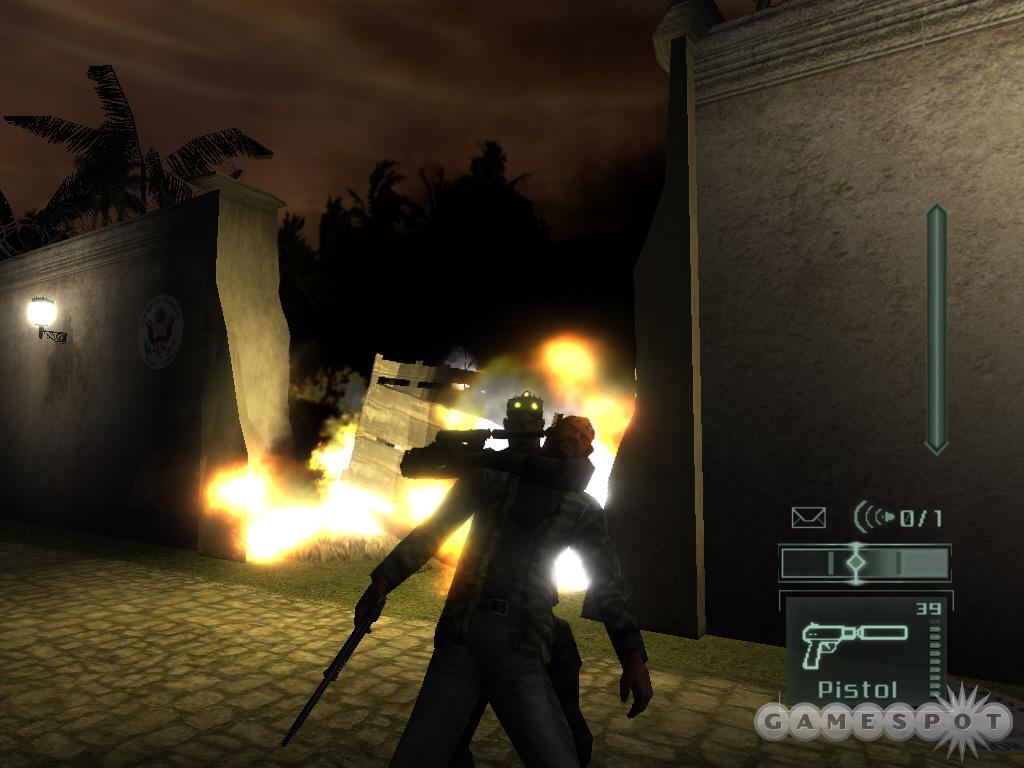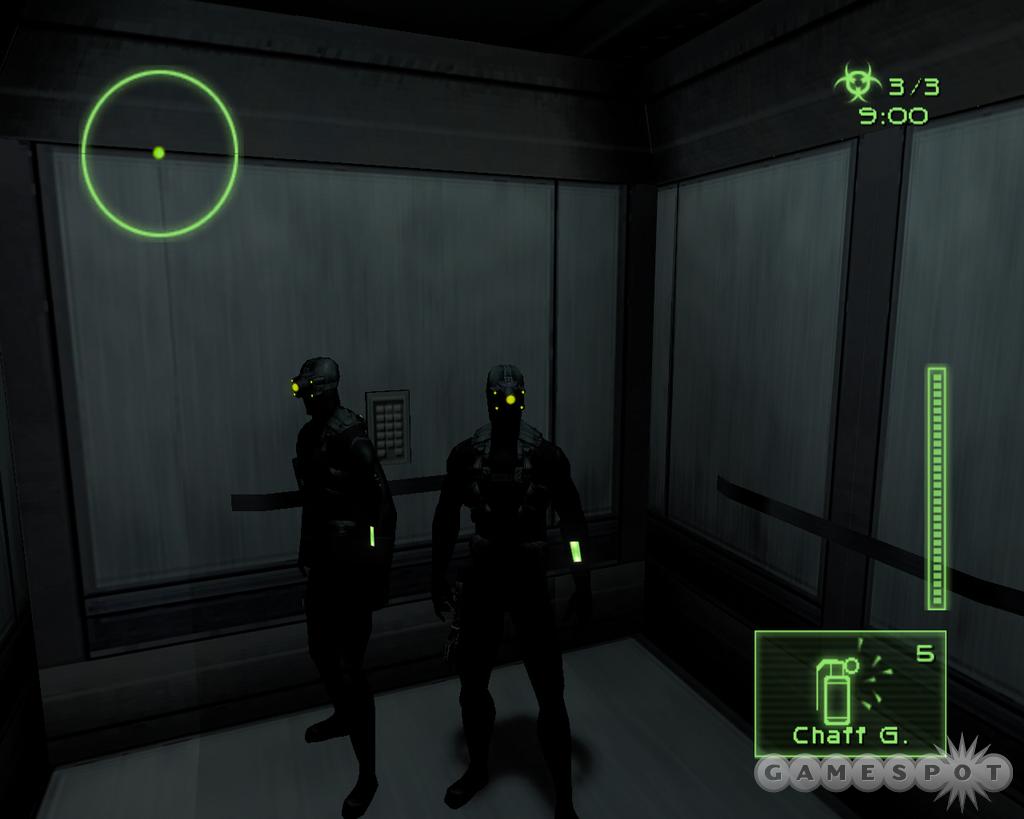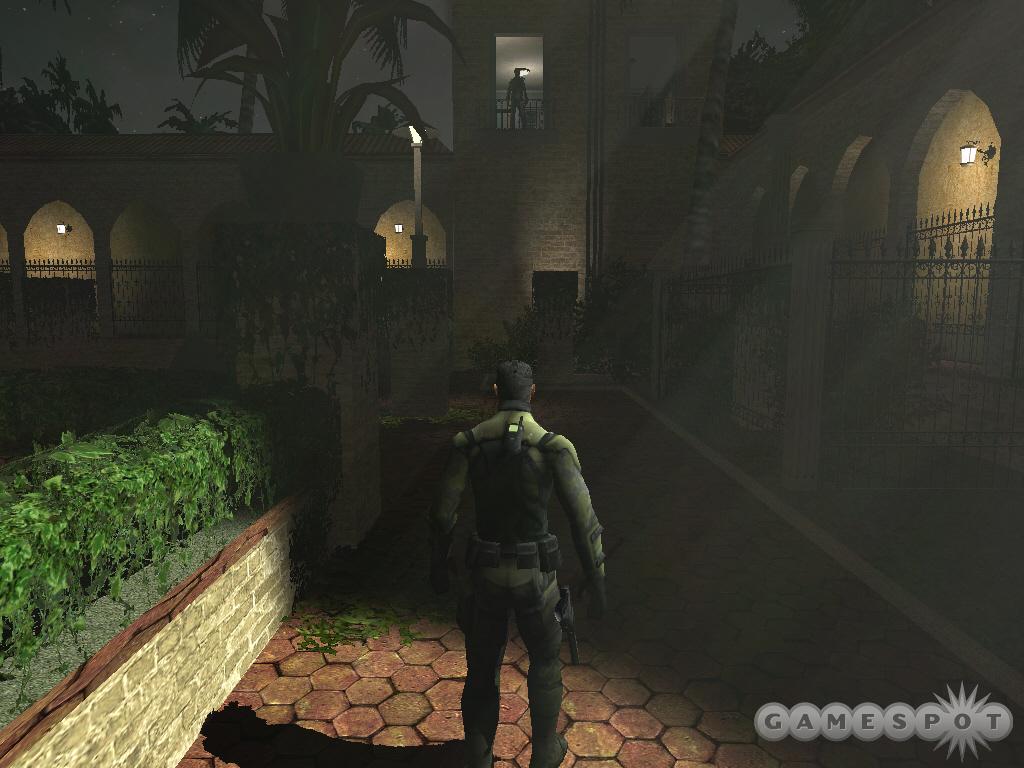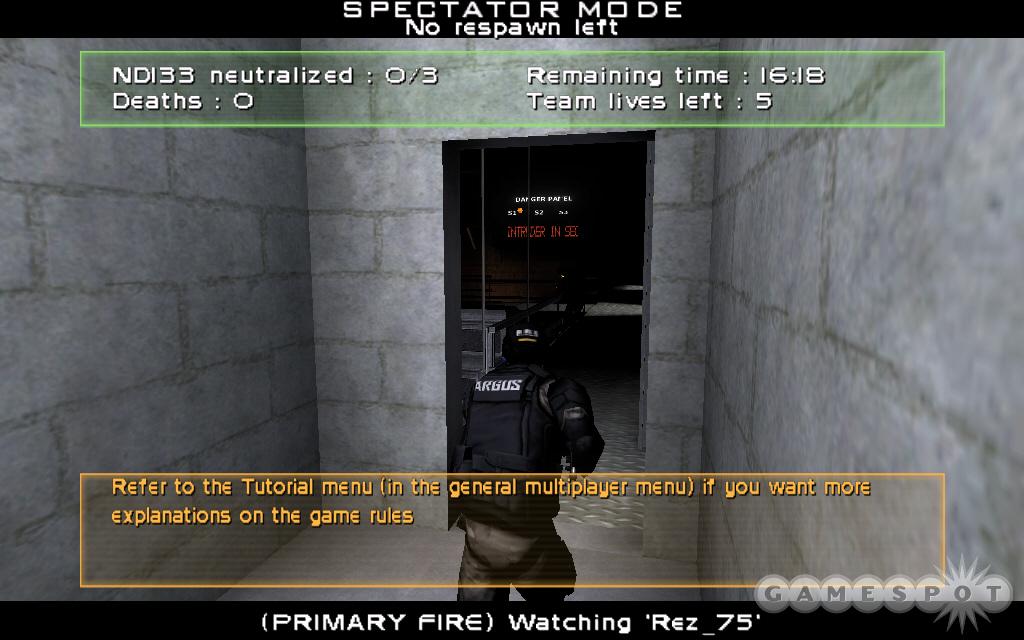Sam Fisher is back, and this time, he's brought some friends. Well, that's not exactly true--Fisher, an ultrasecret agent in league with the US government, always works alone. But the point is, the sequel to Ubisoft's blockbuster hit, Tom Clancy's Splinter Cell, not only offers more of the same spectacular single-player stealth action, starring Sam, that was featured in the original game, but also boasts a genuinely innovative, new multiplayer mode for up to four players, in which small groups of spies must match wits with heavily armed mercenaries. The multiplayer mode ties in with the single-player storyline, though the two portions of the game are completely self-contained. In fact, both the single-player and multiplayer portions of Pandora Tomorrow are highly impressive in their own right and add up to an experience that will surely appeal to fans of the first Splinter Cell, let alone anyone remotely interested in a game about high-tech stealth, subterfuge, and sabotage.

The title of Pandora Tomorrow refers to a code phrase used by the presumed villain of the game, a guerrilla leader threatening the free world with a biological contagion. In the single-player portion of the game, you'll reprise the role of Sam Fisher and track this culprit around the globe, in locations ranging from a speeding passenger train hurtling across Paris, to a military camp in Indonesia. The first Splinter Cell game took place predominantly in building interiors, which were richly detailed but naturally mundane. One of Pandora Tomorrow's obvious improvements on its predecessor is in how it takes place in more-exotic locales. In Indonesia, you'll creep through the heavy brush, perhaps using the dense foliage to hide the bodies of your victims out of sight. On the passenger train, you'll shimmy along the outside to avoid detection and will come dangerously close to being flung to your death from the fast-moving car. This train level comes pretty early on in the campaign and is the shortest and probably the most impressive of the game's missions. There are only eight in total, but most of them are quite long, so veteran Splinter Cell players should expect a good 10 hours' worth of action.
The core gameplay is basically the same, which, for the most part, is a very good thing. You'll sneak your way through the game's linear scenarios, avoiding or incapacitating any unsuspecting guards (or, sometimes, civilians) who might otherwise threaten your mission of secrecy. It's not difficult to alert passersby to your presence, either by moving too quickly (or otherwise making too much noise) or by blundering into a well-lit area. There are other nasty surprises in store for you. Hidden antipersonnel mines (visible only when you toggle your thermal vision), infrared trip wires (likewise), booby traps, motion detectors, security cameras, and other such devices make the going quite difficult.
You've got plenty of tricks up your sleeve, too. Fisher is typically armed with a silenced pistol as well as his trusty SC20K multipurpose experimental assault rifle, which he can use for some silent sniping when lethal force is permitted or which he can use to fire off a variety of different gadgets. Those who played Splinter Cell will recognize all of these, which range from diversionary cameras to smoke grenades to electrifying (but nonlethal) rounds. Fisher's other gadgets include lock picks, an optical fiber wire used for seeing what's on the other side of a closed door, and his combined night vision/thermal vision goggles. He's fully decked out to get the job done by any means necessary.

Pandora Tomorrow's storyline is somewhat more cohesive than that of its predecessor, and some of the gameplay elements are thankfully a bit more transparent this time around. For example, the game inherits a somewhat contrived element from its predecessor: In Splinter Cell you needed to hide the bodies of your victims out of sight to avoid setting off an alarm, which would possibly result in the failure of your mission. You needed to hide all bodies even when there was no one left conscious to pay them much heed. Pandora Tomorrow at least makes it clear that this is always necessary, and a helpful blip on your stealth meter (which indicates how camouflaged you are in the darkness) lets you know where it's safe to dump a body so no one will notice. Also, in most missions, you don't automatically fail if an alarm is sounded; you'll be afforded up to three such mistakes, though at scripted points in each mission, the alarm stage will reset back to zero, and you'll be able to proceed somewhat less anxiously.
Yet, much like the original Splinter Cell, it must be said about Pandora Tomorrow that it occasionally devolves into pure trial-and-error gameplay. The missions are completely linear and tightly scripted, so if you're jumped by bad guys or you stumble over a trap of some sort and thus fail your mission, you'll just reload from the last check point (or quick save, if you're playing the PC version), and then try again from a previous point, this time knowing exactly what's coming up. That doesn't mean you'll always get through the tight spots on the second attempt, as in fact, Pandora Tomorrow is quite a difficult game. Some sequences demand you to silently make your way through environments while using both your night vision and your thermal vision to see all the dangers in your surroundings. Then you might need to silently take out a small squad of guards.

Enemy artificial intelligence is about the same as in the previous Splinter Cell, which means guards will basically patrol around in a set pattern, giving you the opportunity to sneak up on them or shoot them. If you make too much noise or otherwise reveal your position, though, they'll either come investigate if you weren't too blatant about it (usually setting themselves up for an easy kill or knockout), or they'll open fire and/or sound an alarm. Fisher can't sustain much damage, but it's still quite easy to outshoot your enemies as long as you don't alert too many of them at a time. The fact that the gameplay sequences in which you aren't permitted to use lethal force are so much harder than the ones in which you can shoot to kill says a lot about the AI.
While Pandora Tomorrow's missions, like those of Splinter Cell, could have benefited from feeling less rigid and scripted, on the plus side, they're incredibly slick. Each one features some very cool, memorable moments, and you'll find considerable variety and multiple objectives within each mission. And the missions do present you with some tactical options. For instance, there are many more breakable lights in Pandora Tomorrow than in its predecessor, so you can often create a shroud of darkness for yourself with some well-placed shots. You can snipe your foes, sneak up behind them and knock them out, or distract them by whistling (one of Fisher's few new tricks) and then sneak right by. The game unfortunately has no point system of any kind, so there's no built-in impetus to try to accomplish your missions as stealthily as possible, but it's worth noting that the gameplay here is ultimately skill-based, requiring a delicate touch and careful timing. But Splinter Cell fans knew that already.
The control is as responsive as ever. Using the Xbox controller, you'll need to gently apply the analog stick in order to move quietly, lest you make too much noise and alert anyone in the vicinity to your position, while the right analog stick lets you freely rotate the camera to get an ideal vantage point. On the PC, standard shooter-style mouse-and-keyboard controls let you easily maneuver around, and the mousewheel controls how quickly you move. This more-precise control scheme works well--arguably, better--but the analog control and the context-sensitive force feedback provided by the Xbox controller make that version of Pandora Tomorrow a much more tactile experience. The PC version of the game also features sharper, more colorful visuals (assuming you have a good-enough system for them) and gives you the ability to quick-save your progress at any time, whereas the Xbox version is limited to a checkpoint save system, which makes the game more challenging but potentially more frustrating. For what it's worth, the PC version of the game also retails for less than the Xbox version.
Multiplayer Pandora Tomorrow is based on a key plot point in the game, which is alluded to peripherally. Basically, a group called Shadownet--consisting of stealthy guys very much like Sam Fisher, only their faces are completely covered--is charged with sneaking into key areas to dispose of biological weapons in the vicinity. An opposing mercenary force, ARGUS Corp., is commissioned to prevent Shadownet from succeeding. The big twist is that mercenary players view the action from a first-person perspective--and control the action just like in a conventional first-person shooter.

The ARGUS mercs aren't just thugs. Their multipurpose assault rifles are equipped with optional laser sights and torch lights for target identification, and their helmets feature two special vision modes, which allow them to detect spies lurking in the darkness, or traces of their special gadgets. Mercs also have access to anti-spy mines, various grenades, and spy traps, which can cause unsuspecting spies to give away their position. The spies, meanwhile, aren't just Sam Fisher clones, and you'll notice that they control quite differently in some ways. Plus, they have a bunch of unique gadgets of their own. Their electromagnetic rifles are nonlethal but can be used to disable security cameras, motion sensors, and laser trip wires or to temporarily stun enemy mercenaries. Spies also pack flashbang grenades for blinding those pesky mercs and chaff grenades for temporarily disrupting static defenses. They've even got spy bullets, which can mark enemy mercs, revealing their positions on the spies' radars, and allowing the spies to eavesdrop on that merc's voice communications. They can also creep up behind and put unsuspecting mercenaries in a vice grip, in true Sam Fisher style, and then knock them out or kill them.
As you might expect, multiplayer Pandora Tomorrow is a team-oriented affair, and it encourages verbal communication between teammates via communicator headsets--but in a cool touch, if a spy grabs hold of a mercenary, the spy can offer some parting words to the opponent before breaking his neck. It's not game over for the spies if they're caught on camera, but their positions will be revealed on the mercs' minimaps, and sometimes, the area they're in will be temporarily sealed off. Death isn't necessarily the end, either, as both sides have a limited number of lives with which to try to complete their objectives.
The multiplayer action is limited to just four players at a time, and the teams needn't be balanced, so you can have three-on-one matches if you like. There are actually three distinct multiplayer game types based on the aforementioned premise. In the neutralization mode, Shadownet needs to get to and disable several different viral containers, and ARGUS needs to stop them. Extraction mode is kind of like Counter-Strike's hostage rescue; Shadownet needs to find the viral containers and bring them to an extraction point, and ARGUS needs to prevent that from happening. Sabotage is similar to neutralization, but here Shadownet must dispose of the viral containers by hacking into them using modems. It takes a while for the modems to finish the job, so ARGUS has an opportunity to destroy them before the countdown is complete, while Shadownet must make sure the job isn't interrupted.

It seems like it's been a while since any game's multiplayer mode actually warranted a detailed explanation, and that says a lot for the creativity and innovation of this mode. It's executed quite well, too, and can be extremely entertaining if you're playing in good company. The first time you try multiplayer, you're given a quick interactive tutorial of both the Shadownet and ARGUS sides, though you'll need a lot more practice than that. There are just eight maps to choose from, which differ significantly from the single-player settings and include a hospital, a movie theater, a museum, a laboratory, and others. These maps are all shrouded in darkness and lined with air ducts, hidden passageways, multiple points of entry, and other such tactical complexities, so gameplay is still fundamentally all about stealth and tactics--and teamwork, since you'll probably be working with a partner. They're all complexly designed, and neither too small nor too big for four players, so they make for some good, tense action and would probably take a while to really master. Some of them are suitable for one-on-one showdowns, but four-player matches are ideal.
We experienced smooth online gameplay in both the Xbox and PC versions of Pandora Tomorrow's multiplayer mode--when we could get into a match, that is. Via the Xbox Live service, you have the standard quick match and optimatch modes, though a bug in the shipping version of the game unfortunately causes the optimatch menu to freeze up if you wait there for more than 10 seconds or so; you can still set up your own match or search for a random quick match. On the PC, you mostly have the same types of options via Ubisoft's proprietary Ubi.com online service, though this has its own quirks. We experienced crashes to the desktop or other errors trying to get in on numerous matches, which apparently stem from issues with how the game incorporates anti-cheating software. In theory, though, you can easily do a quick search for available matches, create your own, or browse for available matches. The PC version of the game supports voice chat just like the Xbox version does. You can also play the PC version over a LAN or the Xbox version using the system link feature.
Splinter Cell Pandora Tomorrow looks about as impressive as its predecessor, which means it looks outstanding. Beautiful lighting effects and excellent animation make this one of the better-looking games out there. Sam Fisher and his foes mostly recycle all the same animations from the original Splinter Cell, so the visuals won't necessarily be as breathtaking as when you saw them the first time (though Fisher has a few cool, new animations you'll notice). On the other hand, some of the new environments are extremely impressive. Also, some of the new graphical effects for the multiplayer mode are very nice, such as how the ARGUS mercs' vision gets distorted with static when they take a hit. This is an altogether visually stunning game, though it does have a few graphical shortcomings that mar the presentation a bit. The characters who aren't Sam Fisher (or his Shadownet look-alikes) look much less remarkable both in detail and in motion than he does. The game's frame rate is pretty smooth most of the time, but in certain areas it noticeably bogs down, which can be distracting. And the little light sources on Fisher's stealth suit for some reason generate some rather noticeable and unsightly artifacting, an effect similar to when you see "chunks" of color appear while watching a dark scene on some DVDs. On the PC, this isn't a problem, though the simple character models stick out at higher resolutions. But then, nit-picking about Pandora Tomorrow's graphics really is just that.

Most of the audio in Pandora Tomorrow is also excellent, especially Sam Fisher's gravelly voice-over, again provided by career tough-guy actor Michael Ironside. There's some pretty great, dry banter between Fisher and his commanding officer during the course of the game, which helps flesh out these characters a bit more. However, a lot of the voice-over for the game's secondary characters is surprisingly bad--and not only is it amateurish, but it just doesn't fit. The illusion that you're in these various international hotspots is shaken by the fact that almost every voice you hear is speaking in fluent, unaccented English. Fortunately, the rest of the game's audio fares much better. An appropriately tense-sounding musical score again picks up and trails off depending on whether you're sneaking or fighting for your life (though, as in Splinter Cell, the musical transitions are overly abrupt), and ambient noises and various footstep sounds are all very well done.
Judged solely on its single-player offering, Pandora Tomorrow would still be a great follow-up to its predecessor. Its missions are even more densely packed with action, stealth, and intrigue, and its set pieces are even more impressive, though marginally so--Splinter Cell was quite impressive to begin with. But then there's the fascinatingly complex multiplayer mode, which truly is one of a kind and potentially gives Pandora Tomorrow much more lasting value than its predecessor. The sum total is more than deserving of the Splinter Cell namesake and can be highly recommended to most any avid gamer.